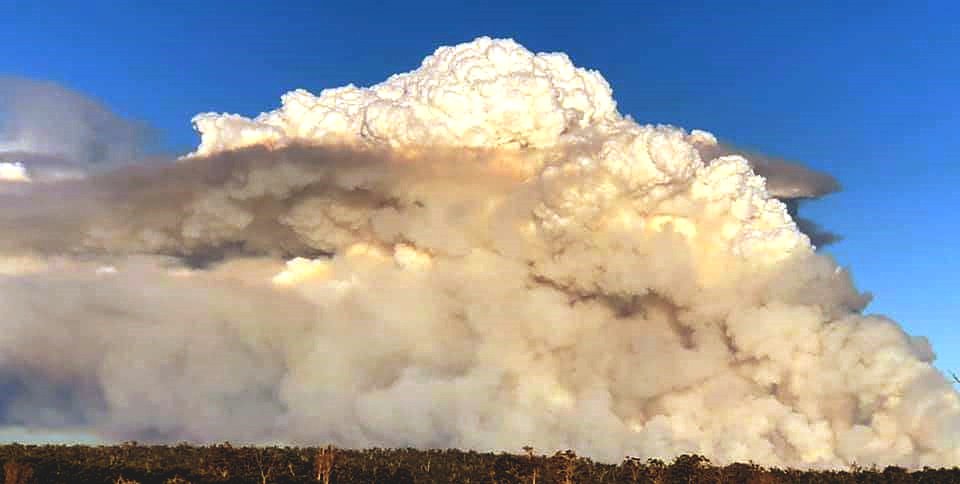
Pyrocloud produced by prescribed burning. Photo credit: Professor Kingsley Dixon
Main Club, 6th August 2021
Our speaker was botanist Professor Kingsley Dixon. Kingsley was the founding director of science at Kings Park and Botanic Gardens, and was in that position for the 32 years before accepting a personal Chair at Curtin University in 2015. It was he who in 1992 discovered the role that smoke plays in the germination of Australian plants after bushfires. In 2016, he was awarded the Western Australian Scientist of the Year. He is active in restoration of bushland, seed science and is a keen gardener.
Tonight, Kingsley talked about the impact of “European fire” on our Australian ecosystems – the subject of a talk that was given in part at the Fire and Biodiversity Forum at Margaret River in June, called “Fire in the Age of Extinction”. His argument is that the burning regimes implemented by the European colonisers over the past 200 years do not respect the Aboriginal custodianship of the land, are inappropriate at the scale, frequency and season of burning, and will negatively impact our already at risk native biota and ecosystems.
Fire is one of the key threats to biodiversity in Australia, along with clearing of vegetation and invasive species. In southwest forests alone in WA, 200,000 ha of State forest and public conservation land are burnt by aerial incendiary based on 6 year fuel ages (for 45% of forest areas for example) under the current prescribed burning regime. But Kingsley said that it takes no consideration of a drying climate, that the same regime applies to all ecosystems and habitats with none exempt, and that there is limited to no pre-burn or post-burn biodiversity impact assessment other than non-scientific ‘burn reports’ by field operators executing the burns. He said that the “fuel age” of each block is now used as a criterion as to when to burn, rather than the actual fuel loads, hence disengaging the level of fuel threat from the need to burn. Prescribed burning silences the provisions of the EPBC (Environment Protection and Biodiversity Conservation) Act. He describes it as the most extensive and intensive human impact since land clearing with few controls other than internal and potentially conflicted self-assessments of impacts, need and methods.
For the southwest, mapping by Kingsley’s research groups shows that the area of prescribed burns is three times the area of wildfires, and it is hard to find any areas that have not been burnt by either wildfires or prescribed burns. This means that the ‘baselines’ of impact of prescribed burnings for understanding long-term impacts are more difficult to find.
Planning for current fire regimes is not sensitive to the specific requirements of different ecosystems and different species. Many plant species are fire-sensitive and some need many decades between burns (e.g. 20 to 30 years for Banksia attenuata). A great deal of the fire-sensitive understorey has already disappeared such as in the areas surrounding Mundaring which has been subjected to high frequency prescribed burning.
Australian flora and fauna have adapted to summer wildfires, but prescribed burns occur at times of the year when most understorey plant species are at maximum growth and flowering (spring is the highest ignition period from mapping done by the Dixon group). Spring burning has a direct impact on fauna recruitment such as being coincident with nesting of many of the 170 bird species native to the southwest.
One distressing, even tragic, feature of the current regime is that areas of old, long-unburnt forest are burnt including the last of the Walpole Wilderness areas. These forests are less prone to wildfires and the burning only makes them more flammable due to production of fine fuel regrowth. Another distressing issue is that of animal welfare. Prescribed burning starts at the perimeter of a block and the fire burns towards the centre, so there is no escape.
Kingsley says that prescribed burns are the major contributor to fire because they cover a greater area than wildfires and they don’t allow forests to reach a mature stage in which they are less flammable based on published evidence.
Prescribed burns have a greater impact on the flora and fauna. The death of Numbats in the recent hot fire in the Perup Block (Weinup burn) was reported as a ‘blunder’. But there was no pre-burn assessment, and it was done against the advice of the communities branch of Department of Biodiversity, Conservation and Attractions (DBCA). There was no plan to avoid the death of Numbats given the intensity of the burn and the few hours from margin burning to full ignition of the 18sq km block. It seems that advice from scientific staff does not influence the decision-makers at DBCA.
He pointed out that the damage done by wildfires is often over-reported. In the recent Wooroloo wildfire, its reported extent was deceptive because 30% of the burnt area was pasture. Grasses burn hot and fast.
From the information Kingsley gave us tonight, it is clear that the strategy being used currently to suppress wildfires is counterproductive and must be changed. In question time he touched on some possible alternative strategies. One is a combination of rapid detection and immediate suppression of wildfires. We have the technology to do that, he said (e.g. micro-satellites). Weed management is another. Mosaic burning may be part of the solution. And there is a plan for Nyoongar people to be co-managers of forest areas, using traditional skills and knowledge to manage the bush as it has been done in the past. Intelligent solutions are needed, using good scientific advice.
For the Fire and Biodiversity Forum, see https://vimeo.com/channels/fabforum
Mike Gregson

